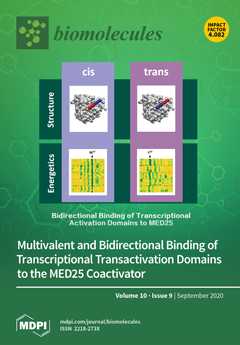Thiosemicarbazones continue to attract the interest of researchers as potential anticancer drugs. For example, 3-aminopyridine-2-carboxaldehyde thiosemicarbazone, or triapine, is the most well-known representative of this class of compounds that has entered multiple phase I and II clinical trials. Two new triapine derivatives
HL
[...] Read more.
Thiosemicarbazones continue to attract the interest of researchers as potential anticancer drugs. For example, 3-aminopyridine-2-carboxaldehyde thiosemicarbazone, or triapine, is the most well-known representative of this class of compounds that has entered multiple phase I and II clinical trials. Two new triapine derivatives
HL1 and
HL2 were prepared by condensation reactions of 2-pyridinamidrazone and S-methylisothiosemicarbazidium chloride with 3-
N-(
tert-butyloxycarbonyl) amino-pyridine-2-carboxaldehyde, followed by a Boc-deprotection procedure. Subsequent reaction of
HL1 and
HL2 with CuCl
2·2H
2O in 1:1 molar ratio in methanol produced the complexes
[CuII(HL1)Cl2]·H2O (
1·H2O) and
[CuII(HL2)Cl2] (
2). The reaction of
HL2 with Fe(NO
3)
3∙9H
2O in 2:1 molar ratio in the presence of triethylamine afforded the complex
[FeIII(L2)2]NO3∙0.75H2O (
3∙0.75H2O), in which the isothiosemicarbazone acts as a tridentate monoanionic ligand. The crystal structures of
HL1,
HL2 and metal complexes
1 and
2 were determined by single crystal X-ray diffraction. The UV-Vis and EPR spectroelectrochemical measurements revealed that complexes
1 and
2 underwent irreversible reduction of Cu(II) with subsequent ligand release, while
3 showed an almost reversible electrochemical reduction in dimethyl sulfoxide (DMSO). Aqueous solution behaviour of
HL1 and
1, as well as of
HL2 and its complex
2, was monitored as well. Complexes
1−
3 were tested against ovarian carcinoma cells, as well as noncancerous embryonic kidney cells, in comparison to respective free ligands, triapine and cisplatin. While the free ligands
HL1 and
HL2 were devoid of antiproliferative activity, their respective metal complexes showed remarkable antiproliferative activity in a micromolar concentration range. The activity was not related to the inhibition of ribonucleotide reductase (RNR) R2 protein, but rather to cancer cell homeostasis disturbance—leading to the disruption of cancer cell signalling.
Full article






